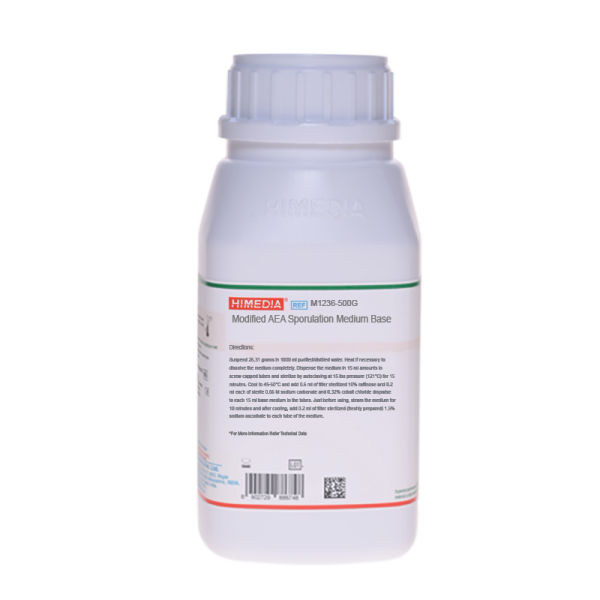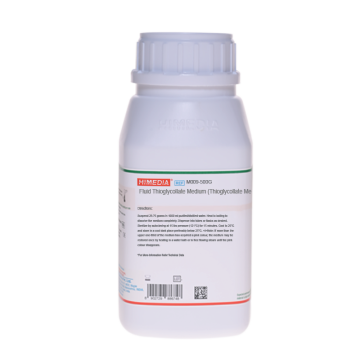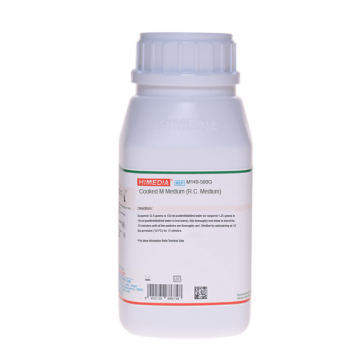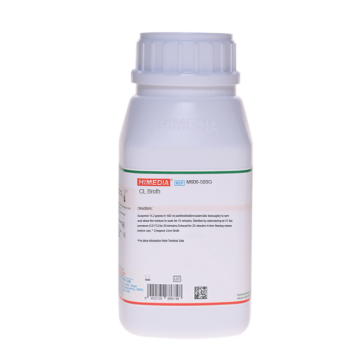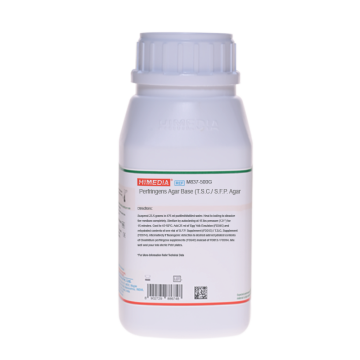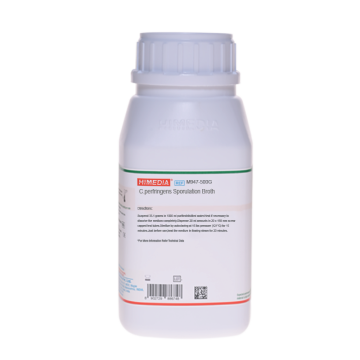 Your enquiry has been submitted
Your enquiry has been submitted
Modified AEA Sporulation Medium Base
Modified AEA Sporulation Medium is used for early sporulation of Clostridium perfringens from foods.
Composition**
| Ingredients | Gms / Litre |
|---|---|
| Biopeptone | 10.000 |
| Yeast extract | 10.000 |
| Disodium phosphate | 4.360 |
| Monopotassium phosphate | 0.250 |
| Ammonium acetate | 1.500 |
| Magnesium sulphate. heptahydrate | 0.200 |
Final pH (at 25°C): 7.8±0.2
**Formula adjusted, standardized to suit performance parameters
Directions
Suspend 26.31 grams in 1000 ml distilled water. Heat if necessary to dissolve the medium completely. Dispense the medium in 15 ml amounts in screw capped tubes and sterilize by autoclaving at 15 lbs pressure (121°C) for 15 minutes. Cool to 45-50°C and add 0.6 ml of filter sterilized 10% raffinose and 0.2 ml each of sterile 0.66 M sodium carbonate and 0.32% cobalt chloride dropwise to each 15 ml base medium in the tubes. Just before using, steam the medium for 10 minutes and after cooling, add 0.2 ml of filter sterilized (freshly prepared) 1.5% sodium ascorbate to each tube of the medium.
Principle And Interpretation
Clostridium perfringens causes food poisoning in humans. Foods may become contaminated with C. perfringens at the abattoir, in transit to shops and market places, etc. The organism is present as vegetative cells in foods (1). A heat labile enterotoxin produced only by sporulating cells induces the major symptoms of diarrhea in perfringens poisoning. Although the enterotoxin is not preformed in the food, the foods in which conditions are favorable for sporulation may contain the toxin. To determine the enterotoxigenicity of C. perfringens from food or faeces, it is necessary to induce sporulation in the organisms. Modified AEA Sporulation Medium (2) recommended by APHA (3), is a modification of the original medium of Taniguti (4) and is recommended for the early sporulation of C. perfringens from foods.
Biopeptone and yeast extract serve as essential sources of nutrients required by bacterial metabolism. Disodium phosphate buffers the medium well. Ammonium acetate, cobalt chloride, sodium carbonate and magnesium sulphate serve as sources of ions required for sporulation. Raffinose is the fermentable carbohydrate. C. perfringens ferments raffinose to produce acid. To test for acid, transfer 1 ml of culture to a test tube or spot plate and add 2 drops of 0.04% bromothymol blue. A yellow colour indicates acid production.
Inoculate about 2 grams of sample in Chopped Liver Broth (M606). Tubes showing turbidity after an incubation at 35-37°C for 20-24 hours are inoculated onto Perfringens Agar Base (M837). Presumptive C. perfringens are further confirmed by performing biochemical tests. Subculture isolates to be tested for enterotoxin in Cooked Meat Medium (M149) and incubate at 35-37°C for 24-48 hours. After incubation, transfer 2-3 drops into Fluid Thioglycollate Medium (M009) and incubate at 35-37°C for 18-24 hours. Re-incubate fresh Fluid Thioglycollate Medium (M009) with this 24 hours old culture. Incubate at 35-37°C for 4 hours. Use the 4 hours subculture to inoculate 15 ml of Modified AEA Sporulation Medium (M1236) and incubate at 35-37°C for 18-24 hours. Check spore formation by examining stained smears (3).
Quality Control
Appearance Cream to yellow homogeneous free flowing powder
Colour and Clarity of prepared medium Yellow coloured clear to slightly opalescent solution
Reaction
Reaction of 2.63% w/v aqueous solution at 25°C. pH: 7.8±0.2
pH
7.60-8.00
Cultural Response
M1236: Cultural characteristics observed after an incubation at 35-37°C for 48-72 hours with added sterile 10% raffinose, sodium carbonate and cobalt chloride solution and sodium ascorbate solution.
| Organism | Inoculum (CFU) | Growth | Raffinose fermentation | Sporulation (observed by examining stained slides) |
|---|---|---|---|---|
| Clostridium perfringens ATCC 12924 | 50-100 | good-luxuriant | positive reaction | positive |
| Clostridium sporogenes ATCC 11437 | 50-100 | good-luxuriant | negative reaction | positive |
Storage and Shelf Life
Store below 30°C in tightly closed container and the prepared medium at 2 - 8°C. Use before expirydate on the label.
Reference
- Collee J. G., Fraser A. G., Marmion B. P., Simmons A., (Eds.), Mackie and McCartney, Practical Medical Microbiology, 1996, 14th Edition, Churchill Livingstone.
- Harmon S. M., and Kautter D. A., 1986, J. Food Prot. 49:706.
- Downes F. P. and Ito K., (Eds.), 2001, Compendium of Methods for the Microbiological Examination of Foods, 4th Ed., APHA, Washington, D.C.
- Taniguti T., 1969, J. Food Hyg. Soc. Jpn. 9: 219.
| Product Name | Modified AEA Sporulation Medium Base |
|---|---|
| SKU | M1236 |
| Product Type | Regular |
| Physical Form | Powder |
| Origin | Animal |
| Packaging type | HDPE |
| References | 1. Collee J. G., Fraser A. G., Marmion B. P., Simmons A., (Eds.), Mackie and McCartney, Practical Medical Microbiology,1996, 14th Edition, Churchill Livingstone. |
| Customized Product Available | No |



